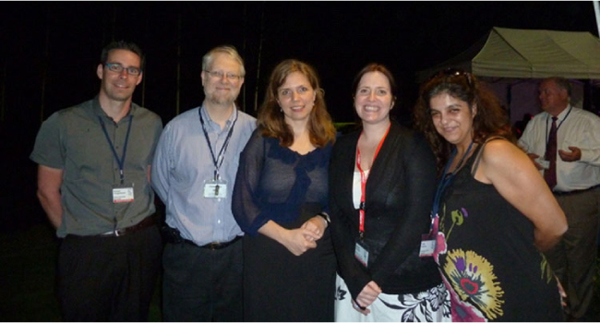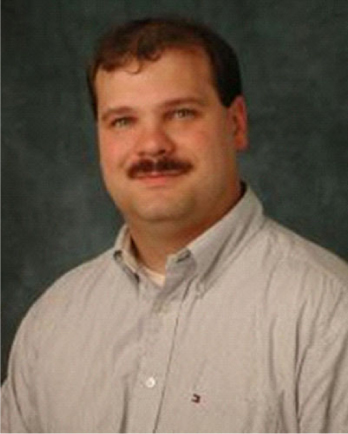The Ever Changing Faces of Polymer Science: The 32nd Australasian Polymer Symposium
Martina StenzelCentre for Advanced Macromolecular Design, University of New South Wales, Sydney, Australia. Email: m.stenzel@unsw.edu.au

Martina Stenzel studied chemistry at the University of Bayreuth, Germany, before completing her Ph.D. in 1999 at the University of Stuttgart, Germany. Sponsored by the DAAD (German Academic Exchange Service), she started working as a postdoctoral Fellow at the UNESCO Centre for Membrane Science and Technology at the University of New South Wales (UNSW), Sydney, Australia. She then started her own academic career in 2002 and since then has been part of the Centre for Advanced Macromolecular Design (CAMD) at UNSW. She is now Associate Professor and ARC Future Fellow. Her research interest is focussed on the synthesis of functional polymers with complex architectures for biomedical applications. She was the chair of the Polymer Division of the Royal Australian Chemical Institute (RACI) from 2008–2011 and is an editor of the Australian Journal of Chemistry. She has received a range of awards, including the 2011 Australian Academy of Science Le Fèvre Memorial Prize. |
Australian Journal of Chemistry 64(8) 979-981 https://doi.org/10.1071/CH11310
Published: 19 August 2011
I remember my first Australasian Polymer Symposium (APS) in Beechworth in 2001, when the RACI Polymer division held a combined meeting with the Australian Society of Biomaterials. Back then, it was a timid looking at each other and getting to know each other. At the next combined meeting in 2006, the28th APS and Australasian Society for Biomaterials 16thAnnual Conference, the members of both societies greeted each other as friends, there was now familiarity between both societies and an understanding that both can learn from each other.[1] And in 2011 at the 32nd APS? There were talks on drug delivery, on cell encapsulation, on tissue engineering. Another combined meeting? No, these were polymer scientists talking biology! But it was not only the marriage of polymers and biology that attracted a lot of attention. There were talks on membranes, lithography, food science, on analytical techniques that were previously more common for physicists or organic chemists than polymer scientists, sensors and other advanced materials. I think it became clear that a lot has happened to polymer science and polymer scientists dared leaving their traditional fields of expertise and venture in new areas, where their skills can make a difference. However, it was clear that even the most adventurous polymer scientists have not forgotten where they come from and they still honor fundamental polymer science. Where else would you find talks which mention proteins, cells and propagation rate coefficients within one slide? Even the most application-oriented polymer chemist was drawn to the presentations on the latest developments in polymer synthesis. After all, many polymer applications have been made possible because some creative polymer scientists came up with new ideas on how to prepare new polymer architectures and somebody developed a good technique that allows the full characterization of the polymer structure. In summary, the 4-day meeting seemed like a feast of polymer science.
Let’s start at the beginning: Sunday greeted us with weather that was just glorious for a conference and every conference organizer’s dream: pouring rain, which barely stopped over the next few days. This did not dampen the good spirits and after two plenary lectures by Ric Kaner, University of California, USA and Christopher Ober (Fig. 1),[2] Cornell University, USA, the almost 300 delegates, including around 100 international delegates, gathered for the welcome reception. The following 3 days saw more than 150 oral presentations and more than 100 posters. Next to a range of excellent contributed lectures, the delegates were treated with four more outstanding plenary lectures by Takuzo Aida, University of Tokyo, Japan, David Castner, University of Washington, USA, Katharina Landfester,[3] Max-Planck-Institute, Germany and Thomas Russell, University of Massachusetts, USA. In addition, several keynote lectures were presented from all areas of polymer science: Kohji Ohno, Institute for Chemical Research of Kyoto University, Rachel O’Reilly (Fig. 1),[4] University of Warwick, UK, Vivek Prahbu,[2] Materials Science and Engineering Laboratory, National Institute of Standards and Technology, Gaithersburg, MD, Geoff Spinks,[5] University of Wollongong, Australia, Kelly Velonia (Fig. 1), University of Crete, Greece, Yusuf Yagci,[6] Istanbul Technical University, Turkey, Per Zetterlund,[7] University of NSW, Australia, Kristi Anseth, University of Colorado, USA, Christopher Bowman (Fig. 2),[8,9] University of Colorado, USA, Michael Brook, McMaster University, Canada, Neil Cameron, University of Durham, UK, Richard Hoogenboom (Fig. 1),[10] Ghent University, Belgium, Marc Hillmyer,[11] University of Minnesota, USA, Bert Klumperman,[12] Universiteit Stellenbosch, South Africa, Andrew Lowe,[13] University of NSW, Australia, Laurence Meagher, CSIRO, Australia and George Simon, Monash University, Australia.

|

|
The international year of chemistry 2011 did not go unnoticed past the polymer community. Christopher Ober, president of the IUPAC Polymer Division, addressed the audience and greeted the delegates on behalf of IUPAC. His laudation to polymer science was complemented by a plenary lecturer by Richard Evans (CSIRO, Australia), who shed light on polymer research in Australia celebrating the Australian plastic money, plastic lenses, contact lenses and other achievements of polymer research. In recent years polymer science in Australia has been associated with RAFT polymerization.[14] But who would have known that conducting polymers were discovered in Australia?[15] Unfortunately, for the inventors, they did not go ahead and publicize their discovery widely. And the Nobel Prize went to a different team of researchers… The lecture by Richard Evans was the concluding plenary lecture of the conference. And just in time for the conference dinner, the rain stopped and the delegates headed to Bonville Golf Course to have their dinner under starlight. There were many highlights during the evening, but most notably were the awards presentations. Traditionally, the APS awards the Trelor Prize for the best student oral and poster presentation. The conference saw a significant portion of presentations given by students, not only poster presentations but also many oral presentations. John Moraes (Sydney University)[16] and Vien T. Huynh (University of New South Wales) received the Trelor prize for best oral and poster presentation, respectively. The Sangster Polymer Science and Technology award, which is given to an outstanding polymer scientist under the age of 40, was awarded to Professor Michelle Coote from the Australian National University in Canberra. The 32APS also held the inaugural presentation of the Bruce Guise award. Bruce Guise, an outstanding industrial polymer scientist, dedicated his life not only to his research but also the polymer community in Australia. Dr Huan Toh from Carl Zeiss (former Sola) was the first recipient of this award for his contribution to the development of plastic lenses.
At last, Australian polymer community had a little surprise award at hand. Occasionally, an award is given to an eminent international scientist who has supported the Australian polymer community over an extended period of time. Professor Christopher Bowman from the University of Colorado had various research collaborations with different Australian researchers over many years. He frequently visited Australia and also attended many Australian Polymer Symposia,[17] often together with his research group. He became a true friend of many Australian scientists. The polymer community felt strongly that we would like to say thank you with this award, which has only been given once before, for many years of friendship and scientific partnership.
This was the end of the 32nd Australiasian Polymer Symposium. I am curious to see where polymer science will be going in the future, but it seems that from modest beginnings it has become a force within chemistry. It takes parts of all the other disciplines and creates something unique. I am looking forward to many APSs in the next few years, but first of all I am looking forward to the next APS, the 33rd Australasian Polymer Aymposium in February 2012 in Hobart (www.33APS.org.au), which will be chaired by Sebastien Perrier from Sydney University.
When the delegates were asked about feedback they enjoyed ‘the scientifically high quality of the talks, the high-caliber invited speakers, the international flair and ….ah yes…that there was always fruit on the table’.
References
[1] G. T. Russell, M. H. Stenzel, Aust. J. Chem. 2006, 59, 477.| Crossref | GoogleScholarGoogle Scholar | 1:CAS:528:DC%2BD28XptlOntr0%3D&md5=88436716781114db380fa096abff19ddCAS |
[2] V. Prabhu, S. Kang, R. Kline, D. DeLongchamp, D. Fischer, W-l. Wu, S. Satija, P. Bonnesen, J. Sha, C. Ober, Aust. J. Chem. 2011, 64, 1065.
[3] K. Landfester, U. Paiphansiri, Y. Reyes, S. Carola Hoffmann-Richter, Theisinger, Aust. J. Chem. 2011, 64, 1054.
[4] J. Du, H. Willcock, N. S. Ieong, R. O’Reilly, Aust. J. Chem. 2011, 64, 1041.
[5] G. Spinks, S. Naficy, H. Brown, J. Razal, P. Whitten, Aust. J. Chem. 2011, 64, 1007.
[6] Y. Yagci, M. A. Tasdelen, Aust. J. Chem. 2011, 64, 982.
[7] S. Ting, E. Hee Min, P. Zetterlund, Aust. J. Chem. 2011, 64, 1033.
[8] R. Sheridan, B. Adzima, C. Bowman, Aust. J. Chem. 2011, 64, 1093.
[9] C. Moorhoff, W. Cook, F. Chen, D. Ngheim, C. Braybrook, S. Thang, J. Sun, C. Bowman, T. Scott, Aust. J. Chem. 2011, 64, 1082.
[10] H. Lambermont-Thijs, M. Fijten, U. Schubert, R. Hoogenboom, Aust. J. Chem. 2011, 64, 1026.
[11] M. Hillmyer, E. Cussler, W. Phillip, S. Moench, M. Roerdink, M. A. Amendt, Aust. J. Chem. 2011, 64, 1073.
[12] W. Hadasha, M. Mothunya, N. Akeroyd, B. Klumperman, Aust. J. Chem. 2011, 64, 1099.
[13] A. Lowe, M. A. Harvison, P. J. Roth, T. Davis, Aust. J. Chem. 2011, 64, 992.
[14] (a) G. Moad, S. H. Thang, Aust. J. Chem. 2009, 62, 1379.
| Crossref | GoogleScholarGoogle Scholar | 1:CAS:528:DC%2BD1MXhsVers7bF&md5=9120ad85e14671fc121b616024ec720dCAS |
(b) G. Moad, E. Rizzardo, S. H. Thang, Aust. J. Chem. 2009, 62, 1402.
| Crossref | GoogleScholarGoogle Scholar |
[15] (a) R. McNeill, R. Siudak, J. H. Wardlaw, D. E. Weiss, Aust. J. Chem. 1963, 16, 1056.
(b) B. A. Bolto, D. E. Weiss, Aust. J. Chem. 1963, 16, 1076.
(c) B. A. Bolto, R. McNeill, D. E. Weiss, Aust. J. Chem. 1963, 16, 1090.
[16] J. Moraes, T. Maschmeyer, S. Perrier, Aust. J. Chem. 64, 000.
[17] L. M. Johnson, H. J. Avens, R. R. Hansen, H. L. Sewell, C. N. Bowman, Aust. J. Chem. 2009, 62, 877.
| Crossref | GoogleScholarGoogle Scholar | 1:CAS:528:DC%2BD1MXpvFeltrY%3D&md5=7864d86a0bf080787cb6d962b9e051f3CAS |


